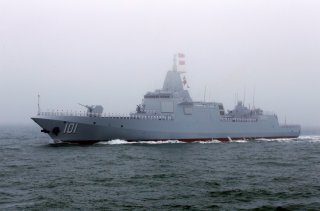China's Type 055 Destroyer "Borrows" USS Zumwalt Stealth Technology
The United States will have issues tracking the this Chinese ship.
Here's What You Need To Remember: In summary, it seems one could accurately characterize the appearance of the Nanching as a bit of a hybrid blending between a stealthy USS Zumwalt and an armed Arleigh Burke-class destroyer.
The Chinese People’s Liberation Army Navy is preparing to deploy a new, stealthy, heavily armed high-tech class of Type 055 destroyer intended to offer sea attack, air defenses, and wartime support to carriers to carriers and amphibs at war on the open ocean.
A story from China’s People’s Online Daily says the Nanchang, a first-in-class new generation of destroyers can fire anti-ship missiles, surface-to-air missiles, anti-submarine missiles, and even land-attack missiles. China apparently plans to deploy the new destroyer in support of two of its operational aircraft carriers, the Liaoning and Shandong, the article says.
Commissioned earlier this year in January, the Nanchang has now completed its first replenishment exercises at sea. Interestingly, the ship represents China’s effort to engineer a stealthy destroyer by virtue of its blended body-bow, smooth exterior, absence of large protruding deck masts and few external deck-mounted weapons. In some respects, the ship does appear to resemble some elements of the U.S. Navy’s stealthy USS Zumwalt destroyer. The Nanchang has very similar-looking deck-mounted guns and a smooth, flat, roundly curved deckhouse. Like the USS Zumwalt, there is a decidedly linear, inwardly-angled hull-deckhouse connection. It has narrow command post windows and appears to mirror the hull deckhouse configuration of the USS Zumwalt to some extent with radar panels blended into sides of the ship. Also, the central placement of the deckhouse, blended with a back end area, might represent a deliberate effort to align the ship’s center of gravity and therefore decrease the possibility of capsizing in rough seas.
Some of the ship’s stealth features were pointed out in a 2018 story in The Diplomat which describes the ship as having a “flared hull with distinctly stealthy features including an enclosed bow,” and hidden mooring points and anchor chains. This deck structure indeed does reveal an apparent attempt to engineer a ship with a lower radar signature, as there are no externally mounted, angular or protruding weapons systems hanging from the sides of the ship. There are few separated large, pointy antenna masts apart from one aligned straight up on top of the deckhouse and a small cluster on the back end.
However, unlike the USS Zumwalt which aligns VLS (Vertical Launch Systems) along the periphery of the ship deck, the Diplomat describes the Type 055 destroyers as having a “64 cell block of VLS.” More concentrated VLS might seem to leave a ship more vulnerable to catastrophic attack should an incoming weapon hit the centralized group of VLS. Having VLS on the periphery, however, would enable many VLS to sustain functionality in the event that some were disabled or destroyed by enemy attacks. Also, closely stacked VLS would emit a larger heat signature should multiple missiles be launched concurrently.
Finally, the back of the Nanchang looks a little “busier” than the USS Zumwalt; there does not appear to be a large, flat rectangular helo landing area on the Nanching but rather a series of small antennas and mounted weapons and sensor systems on the back end. These, it would seem, appear less stealthy than a USS Zumwalt but bring an added advantage of close-in or attached firepower. For example, the Diplomat article points out an “eleven barrel H/PJ-11 30mm Cose-in-Weapons System. The USS Zumwalt does not appear to have a deck-mounted Close-In-Weapons System as an Arleigh Burke-class Destroyer does. CWIS can offer a critical last-layer attack-defense weapon able to use a phalanx area gun to knock out approaching close-in drones or small boat attacks—by blanketing areas with thousands of small projectiles per minute.
In addition, aggregated antennas in the back might localize the ship’s electromagnetic signature to some extent, enabling directional emissions and a single, concentrated signal area. This would preclude a need to emit multiple signals from different locations, potentially spreading out an electronic footprint. The deck-mounted guns on the Nanchang are less cylindrical and elongated as they are on the USS Zumwalt. In summary, it seems one could accurately characterize the appearance of the Nanching as a bit of a hybrid blending between a stealthy USS Zumwalt and an armed Arleigh Burke-class destroyer.
The Nanchang could also help support the Chinese expeditionary mission scope such as its increased amphibious assault capabilities and expansionist strategies. As far back as 2011, the Chinese Navy has been on the radar for its rapid maritime build-up, according to an essay in National Defense University Press which cites Chinese Frigate and Amphib construction. The 2011 paper, called “The Chinese Navy: Expanding Capabilities, Evolving Roles,” says the Chinese had at that point built 12 new Frigates, a new generation of fast-attack craft and a Type 071 20-ton Amphibious Landing Platform Dock warship. The LPD, as described by the essay, carries two helicopters, two air-cushioned landing craft, and the ability to carry up to eight hundred troops. These Chinese naval assets offer a series of mission scenarios through which the PLA Navy could use its new Nanching destroyer to fortify expansionist aims.
Kris Osborn is the defense editor for the National Interest. Osborn previously served at the Pentagon as a Highly Qualified Expert with the Office of the Assistant Secretary of the Army—Acquisition, Logistics & Technology. Osborn has also worked as an anchor and on-air military specialist at national TV networks. He has appeared as a guest military expert on Fox News, MSNBC, The Military Channel, and The History Channel. He also has a Masters Degree in Comparative Literature from Columbia University.
This first appeared earlier and is being reposted due to reader interest.
Image: Reuters.

